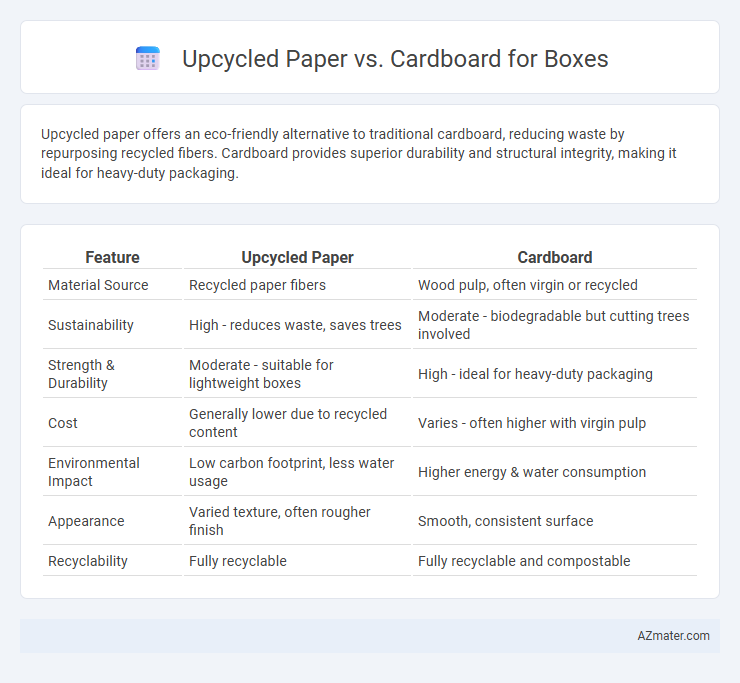Upcycled paper offers an eco-friendly alternative to traditional cardboard, reducing waste by repurposing recycled fibers. Cardboard provides superior durability and structural integrity, making it ideal for heavy-duty packaging.
Table of Comparison
| Feature | Upcycled Paper | Cardboard |
|---|---|---|
| Material Source | Recycled paper fibers | Wood pulp, often virgin or recycled |
| Sustainability | High - reduces waste, saves trees | Moderate - biodegradable but cutting trees involved |
| Strength & Durability | Moderate - suitable for lightweight boxes | High - ideal for heavy-duty packaging |
| Cost | Generally lower due to recycled content | Varies - often higher with virgin pulp |
| Environmental Impact | Low carbon footprint, less water usage | Higher energy & water consumption |
| Appearance | Varied texture, often rougher finish | Smooth, consistent surface |
| Recyclability | Fully recyclable | Fully recyclable and compostable |
Introduction to Upcycled Paper and Cardboard Boxes
Upcycled paper and cardboard boxes offer sustainable packaging solutions by repurposing waste materials into durable containers. Upcycled paper is crafted from recycled fibers, reducing environmental impact while maintaining strength and flexibility for light to medium-weight products. Cardboard boxes, typically made from layers of kraft paper, provide robust protection and cushioning, ideal for shipping and storage in various industries.
Environmental Impact: Upcycled Paper vs Cardboard
Upcycled paper significantly reduces environmental impact by diverting waste from landfills and lowering the demand for virgin fibers, thus conserving trees and reducing energy consumption during production. Cardboard, while recyclable, generally requires more raw materials and energy to manufacture, contributing to higher carbon emissions. Choosing upcycled paper for boxes enhances sustainability through waste minimization and resource efficiency compared to traditional cardboard.
Raw Material Sourcing and Sustainability
Upcycled paper for boxes utilizes post-consumer waste, reducing the demand for virgin fibers and minimizing landfill contributions, promoting a circular economy. Cardboard primarily relies on virgin pulp from sustainably managed forests or recycled fibers, with varying environmental impact depending on certification like FSC or PEFC. Upcycled paper generally offers a lower carbon footprint and resource consumption compared to traditional cardboard, making it a more sustainable choice for eco-conscious packaging solutions.
Strength and Durability Comparison
Upcycled paper, often made from recycled fibers, offers moderate strength suitable for lightweight packaging but lacks the rigidity required for heavy-duty box applications. Cardboard, especially corrugated varieties, provides superior durability and structural integrity due to its layered construction, making it ideal for protecting fragile or heavy items during transit. When comparing strength and durability, cardboard outperforms upcycled paper by delivering enhanced resistance to crushing, bending, and moisture.
Manufacturing Processes and Energy Use
Upcycled paper involves reprocessing pre-used paper materials, reducing the need for virgin fibers and consuming less energy, typically 30-40% less than cardboard production. Manufacturing cardboard requires pulping fresh wood fibers, a process that is energy-intensive and generates higher carbon emissions due to mechanical and chemical treatments. Energy use in cardboard production often exceeds that of upcycled paper by significant margins, making upcycled paper a more sustainable choice for box manufacturing in terms of manufacturing processes and environmental impact.
Cost Analysis: Upcycled Paper vs Cardboard
Upcycled paper boxes generally offer a cost advantage due to lower raw material expenses and reduced energy consumption during production compared to traditional cardboard. Cardboard, while often pricier, provides greater durability and structural strength, potentially lowering shipping damages and associated costs. Evaluating total cost-effectiveness requires balancing initial material savings of upcycled paper against long-term benefits of cardboard's robustness.
Customization and Printing Options
Upcycled paper offers greater customization possibilities for box manufacturing, enabling intricate designs and diverse color printing due to its smoother surface and flexible texture. Cardboard provides robust structural integrity but has limited printing capabilities, typically accommodating simple logos and basic color schemes best suited for larger fonts and bold graphics. Choosing upcycled paper enhances branding opportunities with high-resolution prints and detailed artwork, while cardboard excels in durability and cost-effective bulk production.
Packaging Performance and Protection
Upcycled paper offers enhanced sustainability but generally provides lower structural strength and impact resistance compared to cardboard, which is engineered for superior durability in packaging applications. Cardboard's layered composition and higher burst strength deliver better protection against compression, punctures, and external forces, essential for heavier or fragile items. Choosing cardboard ensures optimal packaging performance by maintaining product integrity during transit, whereas upcycled paper suits lighter, less demanding shipments with eco-friendly considerations.
Recycling and End-of-Life Considerations
Upcycled paper boxes reduce waste by repurposing pre-used fibers, lowering demand for virgin materials and decreasing landfill contributions. Cardboard, commonly recyclable and biodegradable, supports circular use through established municipal recycling systems but may degrade in quality after multiple cycles. Choosing upcycled paper enhances sustainability by minimizing resource extraction, while cardboard ensures efficient waste recovery and compostability at end-of-life.
Best Applications: Choosing the Right Box Material
Upcycled paper is ideal for packaging lightweight items such as cosmetics, stationery, and small gifts due to its eco-friendly nature and flexibility in design. Cardboard boxes excel in protecting heavier, bulkier products like electronics, appliances, and shipping goods because of their structural strength and durability. Selecting the right box material depends on product weight, protection requirements, and sustainability goals to ensure optimal performance and environmental impact.

Infographic: Upcycled paper vs Cardboard for Box
 azmater.com
azmater.com